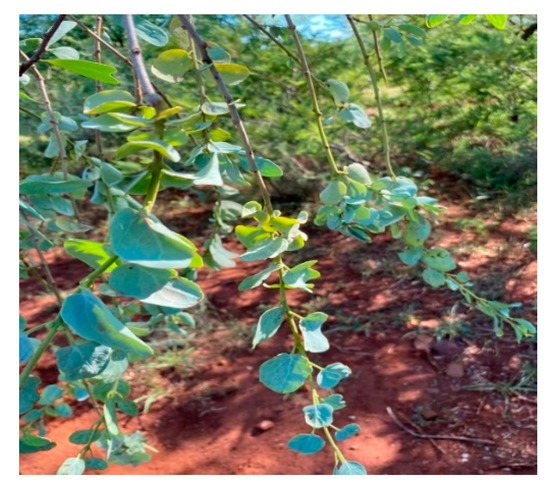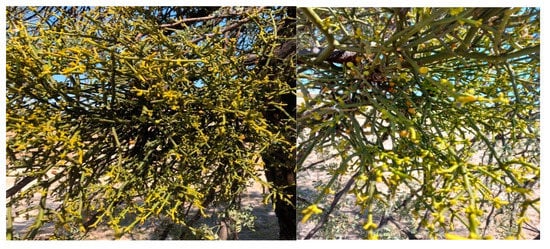You're using an outdated browser. Please upgrade to a modern browser for the best experience.
Please note this is a comparison between Version 1 by Onke Hawu and Version 2 by Conner Chen.
True mistletoe (of the Viscum species) is a semi-parasitic, perennial browse species that is found attached to its host—a shrub or a tree. It has important pharmaceutical and chemical properties that allow it to be used for a variety of purposes, including livestock production.
- semi-arid
- protein
- host
- parasitic
1. Introduction
Finding inexpensive alternative protein sources such as the Viscum species is necessary since livestock productivity has continued to be severely constrained by the cost of livestock feed. True mistletoe (of the genus Viscum) is a semi-parasitic, perennial browse species that attaches to its host, shrubs or various tree species [1][2][1,2]. It is mainly dispersed by frugivorous birds from one host to another [1]. It has fodder value, as well as anthelmintic and therapeutic properties with evergreen leaves [2][3][2,3]. The genus Viscum contains many species that are primarily found in America, Africa, Asia, and Europe [4]. The Viscum spp. found in southern Africa include V. verrucosum, V. rotundifolium, V. anceps, V. songimveloensis, and V. combreticola [5][6][7][5,6,7]. They are fodder resources for ruminants, especially during dry periods when good quality forage is scarce [8]. Öztürk et al. [3] highlighted that the Viscum species extract nutrients and water from their host; hence, they are a rich fodder resource for ruminants.
True mistletoes are ingested and preferred by livestock without any reported digestive orders [9]. Even though their ecological importance for birds, medicinal properties, and fodder value for livestock are known, they are still regularly removed from orchards and rangelands/forests due to their detrimental effect on the host plant [10].
2. Description of the Viscum Species
True mistletoe (Viscum spp.) is an evergreen hemiparasitic plant that inhabits trees. Yellowish flowers, small yellowish green leaves, and waxy, white berries characterize this parasitic plant (Figure 1). Some of the species have leaves while some do not have leaves (Table 1). For example, V. album, when on the branch of a host tree, will grow as much as 60–90 cm long with a drooping yellowish evergreen shrub. It has densely packed forking branches that are 5 cm long, leathery, oval- to lance-shaped leaves that are placed in pairs on branches. The bisexual, or unisexual, blooms are arranged in tight spikes and have consistent symmetry [11]. However, some Viscum spp. have smooth, round, green stems that are covered in sessile, yellowish blooms in tiny clusters (Figure 2). The flowers of the Viscaceae family are narrow, tubular, dioecious, with (or without) a corolla, and thus pollinated by insects and the wind [12].
Figure 1.
Viscum rotundifolium
in Limpopo Province, photo taken by KE Ravhuhali.

Figure 2.
Viscum verrucosum
Harv. in North West Province, photos taken by O Hawu.
Table 1.
Viscum
species and their distribution.
| Distribution | References | |
|---|---|---|
| Viscum spp. with leaves | ||
| V. articulatum | Asia, Australia | [13] |
| V. album | Asia, Europe and Nepal | [14] |
| V. cruciatum | Asia, Africa and Europe | [15][16][17][15,16,17] |
| V. rotundifolium | Africa | [5] |
| Viscum spp. without leaves | ||
| V. angulatum | Asia | [18] |
| V. combreticola | Africa | [19] |
| V. anceps | Africa | [20] |
| V. songimveloensis | Africa | [7] |
| V. verrucosum Harv. | Africa | [21] |
3. Adaptation of the Species
Viscum spp. grow on the branches of various tree species. They extract nutrients and water from the host plant for their survival [22]. Although their leaves may photosynthesize, they do so at a slower rate than their hosts [23]. Ahmad et al. [24] highlighted that they contain a functionally low amount of chlorophyll, and their low capability for photosynthesis explains their capability to adapt to dry conditions. They can survive in semi-arid regions, deserts, temperate woodlands, and semi-tropic wetlands [25]. It has been suggested that true mistletoes selectively parasitize host species that are high in nitrogen since nitrogen is frequently a limiting resource for plants [26]. Moreover, in South Africa, the genus Vachellia are the most important hosts of Viscum spp. Clark et al. [27] highlighted that there are just four Viscum species in South Africa that are unique or specific to a single host, which is a relatively low number.4. Negative Impact and Control of the Viscum Species
It has been extensively researched for years how common Viscum spp. affect woody species, particularly in rangelands and in plantations. Mistletoe inhibits host tree development by reducing carbon absorption and host tree carbohydrates, all of which have an impact on the quality and quantity of woody species produced and the soil’s nutrient cycle [28]. Within its current range, mistletoe abundance has been growing, and the intensification of climatic stress in the form of protracted droughts has increased the rate of tree mortality in mistletoe-infected woody species, thus altering the dynamics of the community [29]. Moreover, true mistletoe spp. induce nutrient and water stress, which, in turn, changes the phyto-hormone profile, as well the defense mechanism of the host plant and causes affected trees to be more susceptible to insect attacks [30]. To overcome such problems, mistletoe spp. infestations should be controlled or managed in the rangelands. Viscum spp. can be controlled using mechanical, chemical, or biological means. The single most successful approach to eradicate mistletoe in rangelands or forests is mechanical removal of mistletoe by clipping infected branches; however, this requires a large amount of labor and finances [28]. The use of chemicals as a control measure has been documented. Further, injecting a chemical into the trunk of a plant with mistletoe has been proposed [31]. However, this method does not address the root of the infestation and entails the possibility that the dosage will either fail to eradicate the mistletoe or harm the host plant. Livestock browse preferably on mistletoes when available; this, therefore, suggests that livestock can be used as biological agents to control the spread of mistletoe spp. However, it is unknown whether livestock have a comparable preference for mistletoes on plant hosts.5. Crude Protein and Fiber Fraction of Viscum Species
The high prices of livestock’s more conventional feeds make Viscum spp. a nutritionally suitable feed for ruminants during particularly dry periods. Grasses during this period normally deteriorate and lose their nutritive value. The nutritive value of Viscum spp. usually varies from one host to another due to link-specific nutrient transfer characteristics [32]. Previous studies have reported that Viscum spp. have a crude protein (CP) content of more than 80 g/kg DM, which is considered to be enough for rumen microbes in growing ruminants (cattle, sheep, and goats) [2][33][2,33]. This further highlights the importance of Viscum spp. during the dry season, as they address protein deficiencies when the CP content of grasses is between 20 and 60 g/kg DM. Hawu et al. [34] highlighted that low CP content usually decreases feed intake, and adversely affects ruminant growth and productivity. The fiber content of forage is one of the most vital parameters to consider as this will affect both feed intake and digestibility for ruminants. Viscum spp. contain relatively low fiber concentrations, as shown in Table 2; this is due to their low photosynthesis capacity. Viscum spp. may not produce some more complex carbon materials such as fiber, which are, however, produced by other woody browse species [35]. Consequently, Viscum spp. do not have high acid detergent fiber, neutral detergent fiber, or acid detergent lignin content, thus making them highly digestible. Therefore, the low fiber content in Viscum spp. does not constrain the use of Viscum spp. as a fodder for ruminants that are adept at utilizing forages that are high in fiber.Table 2.
Chemical composition (g/kg DM) of
Viscum
species.
| Species | DM (g/kg) | CP | EE | NDF | ADF | ADL | References |
|---|---|---|---|---|---|---|---|
| V. album | 960 | 150 | 80 | 339 | 202 | [33][36][33,36] | |
| V. verrucosum | 912 | 121 | 276 | 244 | 75 | [2][2[32],32] | |
| V. rontudifolium | 163 | 241 | 121 | [37][38][37,38] |
DM: dry matter, CP: crude protein, EE: ether extract, NDF: neutral detergent fiber, ADF: acid detergent fiber, and ADL: acid detergent lignin.
6. Health Benefits of Viscum Species in Livestock
6. Health Benefits of Viscum Species in Livestock
In many parts of the world, Viscum spp. have been consumed for a long period of time as an herbal tea and as a supplement to health care [8]. Furthermore, Viscum spp. have been used to improve livestock health, or simply as forage, when feedstuffs are limited due to drought [10,67]. Previous studies have highlighted that Viscum spp. have immunomodulatory, proapoptotic, and antimicrobial properties [8,68]. According to Ishiwu et al. [67], in Nigeria, rural farmers give the leaves of Viscum spp. to goats that have newly given birth, even though they do not, in reality, know of their health benefits. Moreover, Ohikhena et al. [61] highlighted that Viscum spp. are used to treat vision weakness and for promoting muscular relaxation prior to delivery. Drury [69] also highlighted the use of decoctions from Viscum spp. berries in cows to promote the expulsion of the afterbirth and to stop bleeding. In Nigeria, Viscum spp. are used to treat bacterial infections, skin conditions, diarrhea, diabetes, and prostate cancer in livestock [70]. It was reported that salmonellae in sheep rumen fluid were inhibited by diets containing V.verrucosum [71]. Further, Madibela and Jansen [72] highlighted that tanniferous species such as Viscum spp. can reduce the fecal egg count in ruminants. Apart from ruminants, Korean mistletoe enhanced lymphocytes and reduced Salmonella spp. of ceca in broiler hens [73]. Furthermore, Viscum spp. are used to treat infertility, epilepsy, rheumatism, and menopausal syndrome in humans [74].
In many parts of the world, Viscum spp. have been consumed for a long period of time as an herbal tea and as a supplement to health care [8]. Furthermore, Viscum spp. have been used to improve livestock health, or simply as forage, when feedstuffs are limited due to drought [10][39]. Previous studies have highlighted that Viscum spp. have immunomodulatory, proapoptotic, and antimicrobial properties [8][40]. According to Ishiwu et al. [39], in Nigeria, rural farmers give the leaves of Viscum spp. to goats that have newly given birth, even though they do not, in reality, know of their health benefits. Moreover, Ohikhena et al. [41] highlighted that Viscum spp. are used to treat vision weakness and for promoting muscular relaxation prior to delivery. Drury [42] also highlighted the use of decoctions from Viscum spp. berries in cows to promote the expulsion of the afterbirth and to stop bleeding. In Nigeria, Viscum spp. are used to treat bacterial infections, skin conditions, diarrhea, diabetes, and prostate cancer in livestock [43]. It was reported that salmonellae in sheep rumen fluid were inhibited by diets containing V. verrucosum [44]. Further, Madibela and Jansen [45] highlighted that tanniferous species such as Viscum spp. can reduce the fecal egg count in ruminants. Apart from ruminants, Korean mistletoe enhanced lymphocytes and reduced Salmonella spp. of ceca in broiler hens [46]. Furthermore, Viscum spp. are used to treat infertility, epilepsy, rheumatism, and menopausal syndrome in humans [47].
